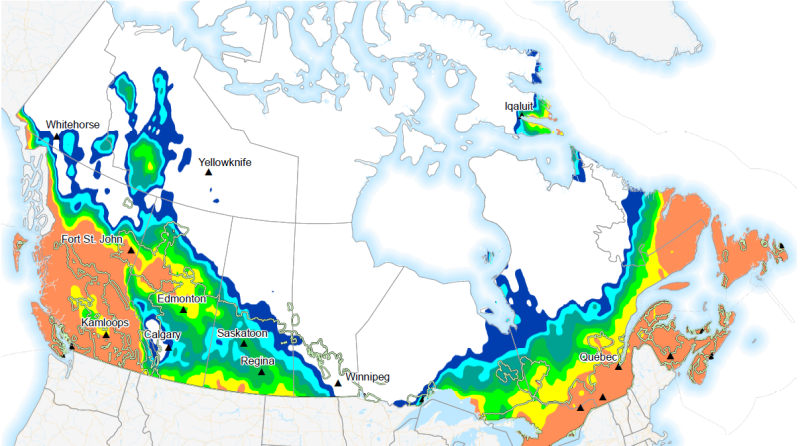RI_533
Type of resources
Available actions
Topics
Keywords
Contact for the resource
Provided by
Formats
Representation types
Update frequencies
status
-

Interactive map that lists major traffic obstacles on the Repentigny road network.**This third party metadata element was translated using an automated translation tool (Amazon Translate).**
-

The probability of effective growing season degree days above 100 for cool season crops. This condition must be maintained for at least 5 consecutive days in order for EGDD to be accumulated (egdd_cool_100prob). Week 1 and week 2 forecasted probability is available daily from April 1 to October 31. Week 3 and week 4 forecasted probability is available weekly (Thursday) from April 1 to October 31. Cumulative heat-energy satisfies the essential requirement of field crop growth and development towards a high yield and good quality of agricultural crop products. Agriculture and Agri-Food Canada (AAFC) and Environment and Climate Change Canada (ECCC) have together developed a suite of extreme agrometeorological indices based on four main categories of weather factors: temperature, precipitation, heat, and wind. The extreme weather indices are intended as short-term prediction tools and generated using ECCC’s medium range forecasts to create a weekly index product on a daily and weekly basis.
-

Mapping of listed trees in Quebec City.**This third party metadata element was translated using an automated translation tool (Amazon Translate).**
-

Information on the nature, duration and obstacles caused by ongoing work on major projects on the City of Montreal's road network.**This third party metadata element was translated using an automated translation tool (Amazon Translate).**
-

Probability of daily precipitation above 25mm over the forecast period (p1d25_prob). Week 1 and week 2 forecasted probability is available daily from September 1 to August 31. Week 3 and week 4 forecasted probability is available weekly (Thursday) from September 1 to August 31. Units: mm Precipitation (moisture availability) establishes the economic yield potential and product quality of field crops. Both dry and wet precipitation extremes have the ability to inhibit proper crop growth. The greatest daily precipitation index covers the risk of excessive precipitation in the short term, while the other indices pertain to longer term moisture availability. Agriculture and Agri-Food Canada (AAFC) and Environment and Climate Change Canada (ECCC) have together developed a suite of extreme agrometeorological indices based on four main categories of weather factors: temperature, precipitation, heat, and wind. The extreme weather indices are intended as short-term prediction tools and generated using ECCC’s medium range forecasts to create a weekly index product on a daily and weekly basis.
-

This data set contains public events in the City of Montreal as broadcast on [the City calendar] (https://montreal.ca/calendrier). The data provides information on the main characteristics of the event, including date, type of event (e.g. show, public session, exhibition), target audience, cost, and location.**This third party metadata element was translated using an automated translation tool (Amazon Translate).**
-

The Government of Canada continues to strive to be ever more open and transparent. This means a government that is open by default providing better digital capacity and services for Canadians. Under a modernized Fisheries Act, Fisheries and Oceans Canada (DFO) has made available an online Fisheries Act (FA) Registry that facilitates access to data and information, including geospatial data, about projects as well as regulatory process information. The new online version of the FA Registry is now available to Canadians. The FA Registry is currently accessible through the Common Project Search Portal, a one-stop online location for Canadians to search and browse through DFO authorizations as well as projects and assessments submitted to the Impact Assessment Agency of Canada and Transport Canada. DFO will be undertaking continuous development of the Fisheries Act Registry. This release is the second step towards implementing the full FA Registry that will provide additional content as well as new features to the FA Registry, increasing transparency and proactive disclosure as well as improving digital capacity and service for Canadians.
-

The Probability (likelihood) of cool wave days for cool season/overwintering crops occurring Cool Wave Days are the number of days in the forecast period with a minimum temperature below the cardinal minimum temperature, the lowest temperature at which crop growth will begin (dcw_cool_prob). This temperature is 5°C for cool season crops. Week 1 and week 2 forecasted probability is available daily from April 1 to October 31. Week 3 and week 4 forecasted probability is available weekly (Thursday) from April 1 to October 31. Cool season crops require a relatively low temperature condition. Typical examples include wheat, barley, canola, oat, rye, pea, and potato. They normally grow in late spring and summer, and mature between the end of summer and early fall in the southern agricultural areas of Canada. The optimum temperature for such crops is 25°C. Agriculture and Agri-Food Canada (AAFC) and Environment and Climate Change Canada (ECCC) have together developed a suite of extreme agrometeorological indices based on four main categories of weather factors: temperature, precipitation, heat, and wind. The extreme weather indices are intended as short-term prediction tools and generated using ECCC’s medium range forecasts to create a weekly index product on a daily and weekly basis.
-

Projects submitted to Transport Canada’s Navigation Protection Program. Please note that where appropriate, the content is displayed in the language of the original submission and has not been altered.
-

The number of days in the forecast period with a minimum temperature below the frost temperature. It is -15°C for herbaceous crops over the dormant period (ifd_herb_dorm). Week 1 and week 2 forecasted index is available daily from November 1 to March 31. Week 3 and week 4 forecasted index is available weekly (Thursday) from November 1 to March 31. Over-wintering crops are biennial and perennial field crops such as herbaceous plants (strawberry, alfalfa, timothy, and many other forage crops) and woody fruit trees (apple, pear, peach, cherry, plum, apricot, chestnut, pecan, grape, etc.). These crops normally grow and develop in the growing season and become dormant in the non-growing season. However, extreme weather and climate events such as cold waves in the growing season and ice freezing events during the winter are a major constraint for their success of production and survival in Canada. The winter survival of these plants depends largely on agrometeorological conditions from late autumn to early spring, especially ice-freezing damage during the winter season. Agriculture and Agri-Food Canada (AAFC) and Environment and Climate Change Canada (ECCC) have together developed a suite of extreme agrometeorological indices based on four main categories of weather factors: temperature, precipitation, heat, and wind. The extreme weather indices are intended as short-term prediction tools and generated using ECCC’s medium range forecasts to create a weekly index product on a daily and weekly basis.
 Arctic SDI catalogue
Arctic SDI catalogue